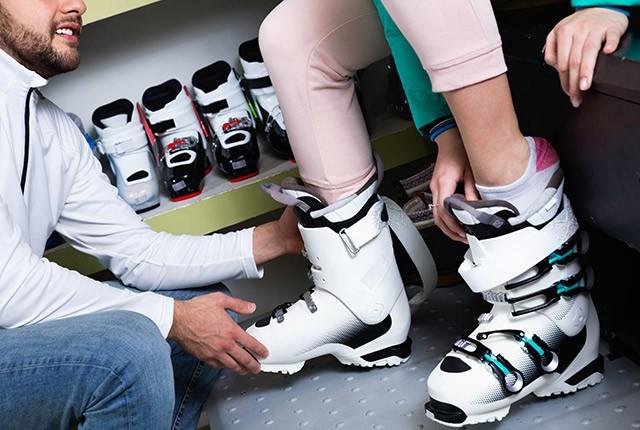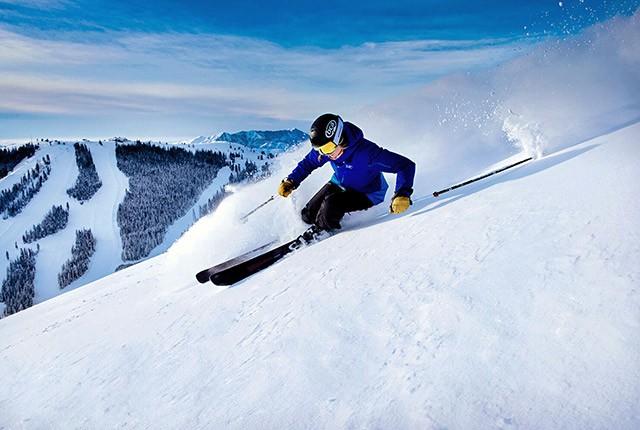Buying new equipment never gets old. The dent left in the wallet is dwarfed by the experience you get when you feel that new gear under foot. The break-in process is minimal and nearly painless for skis and snowboards, but new ski boots can be a much different story. The process of breaking in alpine ski boots can be frustrating and even season-ending. Have heart: There are some steps you can take that can mean the difference of a bad day and a great day, or perhaps loosing a toenail or keeping them all intact at the end of the season.
Ski boots are the iPhones of the mountain, that is they connect you to your skis and help you communicate with them. If you have a sloppy fit or a hotspot on your sixth toe, it’s like having poor cell reception. Like Goldilocks, you’re looking for a boot that flexes and fits just right for your ski ability and terrain choice…not too soft or too stiff and not too big or small.
To continue with the cell phone analogy, if you have a solid fit and the correct flex, you’ll have five bars all day long. You can do some initial legwork such as read online reviews of ski boots or visit the websites of brands you’ve bought in the past to familiarize yourself with the new boot models. The most important thing to do when shopping for new boots, however, is to visit a qualified bootfitter who will study your foot and your specific physical needs as well as asks about your skiing ability.

A savvy bootfitter will help ease the process of breaking in new boots in several ways. First, he or she will size your foot up like a prince searching for Cinderella. With that initial inspection and knowledge of your ski ability, plus taking stock of your basic anatomy, he or she will select a few boot options within a targeted last size, or the inner shape of the boot.
Narrow fitting boots have lasts around 97 mm to 98 mm and are usually the choice for experts who favor a tight fit and stiff flex for power and precision. Medium fitting boots have lasts that hover around 100 mm to 102 mm and have several models that range from stiff to medium flex.
Wide fitting boots—typically over 102 mm and up—have padded liners and comfort features. Women-specific boots often have lower or sculpted cuff options to accommodate for lower and larger calf muscles along with anatomically correct lasts that can help with narrower heels.
Bootfitters are essentially matchmakers, matching each skier with the correct boot category. For example, ski racers get paired up with race boots, often the stiffest in flex with a complete focus on energy transmission. All-mountain or freeride boots may have a hike/ski mode and technologies that reduce weight without skimping on performance to make it easier to hike for turns.
Women-specific boots may have plush liners for comfort and warmth or even built-in boot warmers. Some boots have heat moldable liners, which means the liners can be heated up with your foot inside to create a better fit. Most ski boot models have multiple ways to adjust the fit as well as the canting (including cuff adjustment, which angles the cuff to match the angle of your leg so that your knees track evenly). Essentially, bootfitters fit the boot to your foot and then adjust the boot to work with your body and not against it on the slopes.
After finding the correct last size, category and flex, the bootfitter can now talk to you about customization. Many boot manufacturers have developed technologies that help customize hard-to-fit areas. These hard-to-fit areas are a common irritant for skiers, and with the help of bootfitters, manufactures have made the plastic shell easier to work on with the tools that bootfitters commonly use.
If you already have inflamed areas, a bootfitter can blow out or grind the shell to accommodate for any blatant areas of discomfort. After the initial customization, bootfitters typically like you to ski in the new boots and identify any new hot spots. It helps to mark any areas of discomfort with a sharpie or tape while you’re experiencing the hot spots as you ski, so that you can be clear when you go back to your bootfitter.

You can get some of the breaking in process out of the way by wearing your boots at home before skiing in them. Buckle them up snugly as you would to go skiing and spend at least an hour this way. Flex them back and fourth and side to side, but be careful not to put too much wear on the boot soles (i.e. don’t walk down the driveway to get the mail).
If your feet fall “asleep,” make sure you have a secure wrap of the inner liner around your foot, and buckle your boots snugly but not so tight that it cuts off circulation. Beginner skiers often make the mistake of wearing really thick socks or wearing baselayers inside their boots.
The best course of action is to wear ski socks sold by your bootfitter and to pull your base layer up on your shin, above where the boot cuff comes into contact with your lower leg. It’s important to make sure the boot tongue is in the correct position. If the boot tongue is out of line, it can lead to pain and hot spots. Also, it’s important to buckle the boots for a secure fit, using the power strap to secure the boot tongue around your shin. Taking the time to put your boots on correctly will keep hot spots at bay.
While you’re still in the ski shop, start thinking about pressure areas. Perhaps the top of your foot has a sharp pain, you have a bunion on your big toe, or a bone spur on your heel. Make notes about these hot spots. Some bootfitters may advise getting professional insoles/orthotics made for your boots. Many bootfitters make custom insoles in-house. This will add to the cost of your ski boot purchase, but they typically last for years.
Insoles can help eliminate foot issues in boots the same way orthotics do in shoes. DFP (Dynamic Foot Positioning) based in Salt Lake City, Utah, has been designing custom insoles for over 20 years. “The process we use involves taking a blueprint of your foot,” says Joe Liefer, DFP boot fitter at Christy Sports in Beaver Creek, Colo. “We can see exactly how you distribute your weight on each foot and immediately know where your pressure spots are to then alleviate them.”
Once you get fitted by a bootfitter and a pair of insoles made or bought, don’t be surprised if it takes several trips to you bootfitter to get the right fit. If you take the time early season to dial in your boots, you’ll be happy you did when you still have a full set of toenails at the end of the season.
Read more:
Best Gifts for Snowboarders and Skiers

